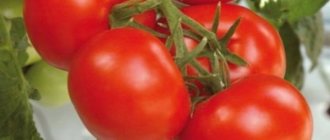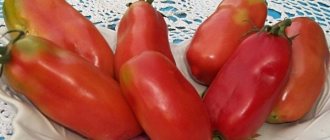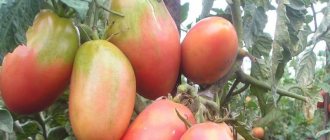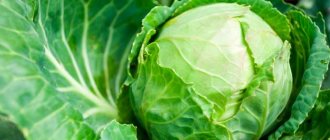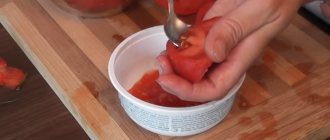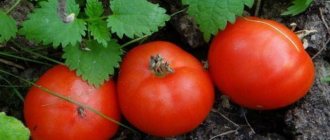Brief hybrid assessment
The manufacturer treated the seeds with low temperature plasma. Germination has increased, resistance to the tobacco mosaic virus has increased, and labor costs during cultivation have decreased. This further increased the quality of the product. The characteristics and description of the variety attract gardeners.
Technical data:
- the bush grows up to 70 – 90 cm;
- the number of leaves is average;
- the first inflorescence is formed after the 6th leaf;
- brushes are laid after 1 – 2 sheets;
- number of fruits in a cluster – 6;
- the weight of one tomato is about 200 g;
- color – rich red;
- the pulp is juicy, acidity is medium;
- the taste is pleasant, the skin is dense, not rough;
- the yield reaches 19 kg/sq.m. m.
The fruits have a universal purpose. They are delicious in salads, chopped vegetables, and juices. When salting or marinating, tomatoes do not crack.
Benefits of Kakadu
It takes 90 days from germination to the appearance of the first berries. This allows you to actively grow tomatoes in open ground. Before the onset of summer cold weather, the gardener will have time to harvest. Late blight will not cause damage. If the temperature suddenly drops, green fruits should be removed. They ripen well in a warm, dark place.
It is recommended to place the crop in one layer in a box and cover it with cotton cloth.
Gardeners give excellent reviews, noting the excellent transportability of ripe fruits. There are no losses during transportation. Universal use, good shelf life, allow you to realize the harvest without loss. To obtain the maximum number of berries, a garter is required. Forming a bush into two stems will reduce the total number of tomatoes, but increase the weight of each. Simple agricultural technology and high yields attract summer residents.
See also
Characteristics and description of the Negritenok tomato variety, its yieldRead
Features of growing tomatoes in open and protected ground
The Kakadu tomato is mainly grown in open ground. This hybrid is immune to cold weather.
In open ground, the first two weeks after planting, tomatoes are covered with film at night. This will protect them from frost.
To prevent the roots of tomatoes from freezing, the beds are mulched. For this purpose, use hay, straw or burlap. In some cases, it is possible to use film.
When growing tomatoes in a greenhouse, the walls of the room are treated with a disinfectant solution. To maintain optimal humidity in the greenhouse, it is regularly ventilated by opening the windows.
In protected soil, it is especially important to help pollinate tomatoes. To do this, the bushes are shaken periodically.
Some tips on agricultural technology
To get a large harvest of tomatoes, you should follow simple rules:
- Sow Kakadu tomato seeds for seedlings 50 days before the intended planting in open ground or an unheated greenhouse. No special treatment is required: the manufacturer took care of it himself.
- When loops appear, place the plants on the windowsill. Temperature 20 degrees during the day, 16 – 18 at night. Illumination with an agricultural lamp is required until 16:00.
- In the phase of 2 true leaves, pick the plants into separate containers. Deepen to the cotyledons.
- Start ventilating the seedlings a week in advance. Anyone who has planted Kakadu knows: hardened plants adapt faster.
- It should be placed in the ground 50 by 40 cm. Per 1 sq. m are adjacent to an average of 8 bushes (in a greenhouse). In open beds, you need to plant 3 to 5 tomatoes in the same area.
- Watering in the morning is initially moderate (2.5 liters of water per plant), then increased during the flowering period (up to 4 liters).
- Fertilize once every 10 days with complex mineral fertilizers. Stop adding additives 2 weeks before harvest.
- Weeding and loosening are carried out as necessary.
For rapid ripening, it is recommended to artificially form the plant into one stem.
Diseases and pests
If all the rules of agricultural technology are followed, Kakadu pepper is little susceptible to infection, but at unfavorable times the following are dangerous for it:
- Late blight. It usually develops on plants planted very close to each other. The disease does not affect crops that are watered regularly, but not in excess, and located in a ventilated place. If seedlings are affected, wet rot appears at the base of the stem, the leaves turn yellow and fall off. On mature plants, brown spots form that grow right before our eyes. In dry air, the leaves dry and curl, and in high humidity they become covered with dark oblong marks. Having appeared on the leaves, late blight quickly spreads to the stems and fruits, causing the latter to rot.
To avoid this problem, with the onset of wet, cold weather, the crop must be treated with Bordeaux mixture once every 10 days. If signs of the disease have already appeared, you will need the drugs Barrier and Phytodoctor.
- Another scourge is crown rot. Formed on the sides of fruits. At first it looks like watery patches, which then turn into dark, long dry spots. The tissue loses color and wrinkles, the affected area becomes concave. Peppers affected by this disease ripen prematurely and may contract another disease - Alternaria. Causes of blossom end rot: lack of calcium, sudden changes in humidity, excess nitrogen fertilizers, damage to roots during soil cultivation. Mushrooms may settle on the surface of defective peppercorns. Peppers are very susceptible to disease within 30 days of fruiting.
To combat blossom end rot, copper sulfate is used, which is sprinkled not only on the plants, but also on the soil underneath them and on the surface of the greenhouse from the inside.
Now a little about the “uninvited guests” that can settle on Kakadu pepper. These include:
- Spider mite. It is extremely difficult to examine the pest itself. The arachnid pierces the leaves of the crop, due to which brown dots are formed, and then the tissue darkens. When a tick moves through a plant, it becomes covered with cobwebs. Its heavily braided areas dry out.
The pest is active at air temperatures above 25. It does not like humidity, so it attacks plants during periods of drought. Protected soil is favorable for tick development, so it often lives in greenhouses.
- Aphid. It feeds on vegetable juice. When this insect appears, the pepper leaves curl and dry out, a syrupy honeydew forms on the surface of the plant parts, the bush becomes sticky and shiny, and pests crawl on the inside of the leaves. Aphids can enter the greenhouse during ventilation, with soil or young cuttings.
To avoid insect invasion, you can plant onions or garlic around the perimeter of the greenhouse, the smell of which repels aphids. Working tools located in the greenhouse must be treated with bleach, especially when planting seedlings.
Gardeners can cope with spider mites and aphids with the help of Karbofos and Atellik. For the same purpose, spraying with ash liquor is used.
Reviews from gardeners about the “golden apple”
The hybrid has found permanent fans. Gardeners appreciated the tomato.
Penguin:
I bought tomato seeds. This is my first year growing Kakadu tomatoes in open ground. At first I was struck by the appearance of the bush: too powerful. I thought I had overfed her. The yield of fruits is friendly. After the first wave came the second. She was ripening it in the pantry. Perfectly transportable. Doesn't crack, doesn't turn black. The harvest was collected before late blight. I prepared juices, salads, and covered them whole. Delicious. I'll plant it next year.
Summer in the village:
I bought planting material “Plasma seeds”. Planted in a greenhouse. The norm is 40 by 50 cm, but more often is possible. Very big harvest. The fruits are ripening together. I liked the early maturation. I think if you don’t pick tomatoes green, the taste will be better.
See also
Description and characteristics of the tomato variety Kish MishRead
Valentina:
Kakadu F1 tomatoes are my favorite. I purchased “Siberian Garden” seeds several years ago. I read the description. At first I doubted it: it was very well presented. Will it happen somehow here in Abakan? In March I sowed it for seedlings. It illuminated, tempered. In May I planted it in a polycarbonate greenhouse according to the scheme. She fed and watered. In mid-June the first ripe fruits appeared. The taste is great! We ate them in salads and just whole. In August, I put the brown and green fruits to ripen. Canned with other vegetables. We had our own tomatoes on the table until September. Very pleased. I recommend it to gardeners living in risky farming areas.
Growing tomatoes
Tomatoes are planted in open ground when the soil warms up. For early ripening hybrids, timely picking to a permanent place is especially important. If the seedlings are left too long, ovaries will appear on them, which will significantly complicate their further cultivation.
Read also: What are the benefits of Chinese quince?
The time for growing tomatoes depends on the region in which the gardener lives:
- in the south - at the end of April;
- in the central part of Russia - in the second half of May;
- in the northern regions - in early June.
Planting seedlings in a permanent place
The beds for tomatoes need to be prepared in advance. In autumn, the soil is dug up and cleared of weeds. It is enriched with mullein, chicken droppings and ash. To reduce the acidity of the soil, it is mixed with lime.
In the spring, the beds are dug up again and cleared of plant roots.
The holes are dug in rows in a checkerboard pattern. Planting pattern 50x40. For 1 sq. m plant no more than 5 plants. It is not recommended to thicken plantings; this will lead to a decrease in yield.
3 days before planting tomatoes in a permanent place, they are watered and fed. Directly when picking, the plants are removed from their pots along with a lump of earth.
Seedlings are planted in holes. The root system is formed towards the center.
Water is poured into the holes. After this, they are sprinkled with soil. The next time the tomatoes are watered after 10 days.
Caring for Kakadu tomato
Kakadu tomatoes, despite their short stature, need to be formed. During this procedure, 2-3 stems are left. The more stems, the later the harvest will appear. The size of the fruit also depends on this factor.
The tomato produces few shoots, but you still have to remove the excess. The yellowed and lower leaves are plucked from the bush. This procedure is carried out early in the morning or in the evening.
The Cockatoo needs to be tied up. Otherwise, its stem will break under the weight of the fruit. A wooden support or trellis is used for gartering.
Tomatoes are watered as the soil dries. Watering should be plentiful, but infrequent. One plant requires 1 to 3 liters of water. On the days of pinching, the soil is not moistened.
The soil must be loosened after each watering and rain. Otherwise, a crust will form on the ground, preventing root air exchange and moisture evaporation.
During the season, tomatoes are fed 3 to 4 times. The frequency of fertilizing depends on the condition of the plants.
Root supplements can be mineral or organic. Experienced gardeners advise alternating these compositions. Complex fertilizers are usually bought in the store, and diluted mullein, chicken droppings or humus are used as organic ones.
Gardener mistakes
When growing tomatoes, beginning gardeners often encounter some difficulties. Typically, this is the result of mistakes they make:
- Garter of tomatoes with natural fabric. From moisture, such material begins to rot, leading to decomposition of the stem. To prevent this from happening, use synthetic material.
- Hope for self-pollination. Tomatoes are a self-pollinating crop, but without the help of gardeners, the yield will be low. When flowers appear, it is recommended to gently shake the bushes daily.
- Applying excessive amounts of fertilizing. As a result, the green mass develops, and the fruits become sparse and small.
- Lack of fertilizers. This is fraught with withering of the leaves and failure to form ovaries.
- Refusal of hilling. If roots have formed on the stem of the plant, they must be covered with soil. Otherwise, the plants will wither and die.
Diseases and pests
The cockatoo is immune to the most common tomato diseases. He does not suffer from late blight and tobacco mosaic.
However, preventive measures cannot be neglected:
- It is necessary to disinfect not only the soil, seeds and containers for growing seedlings, but also garden tools.
- Be sure to remove the remains of crops that previously grew in tomato beds. They may contain pathogens.
- Weed your tomato beds regularly. Weeds contribute to the development of fungal and viral infections and also attract pests.
- Follow the rules of watering and planting. It is improper soil moisture that creates ideal conditions for the development of infections.
- Protect plants from pests. Treat tomato bushes with soap solution, infusion of dandelion and celandine. Collect large beetles by hand. Egg shells will help get rid of mole crickets.
